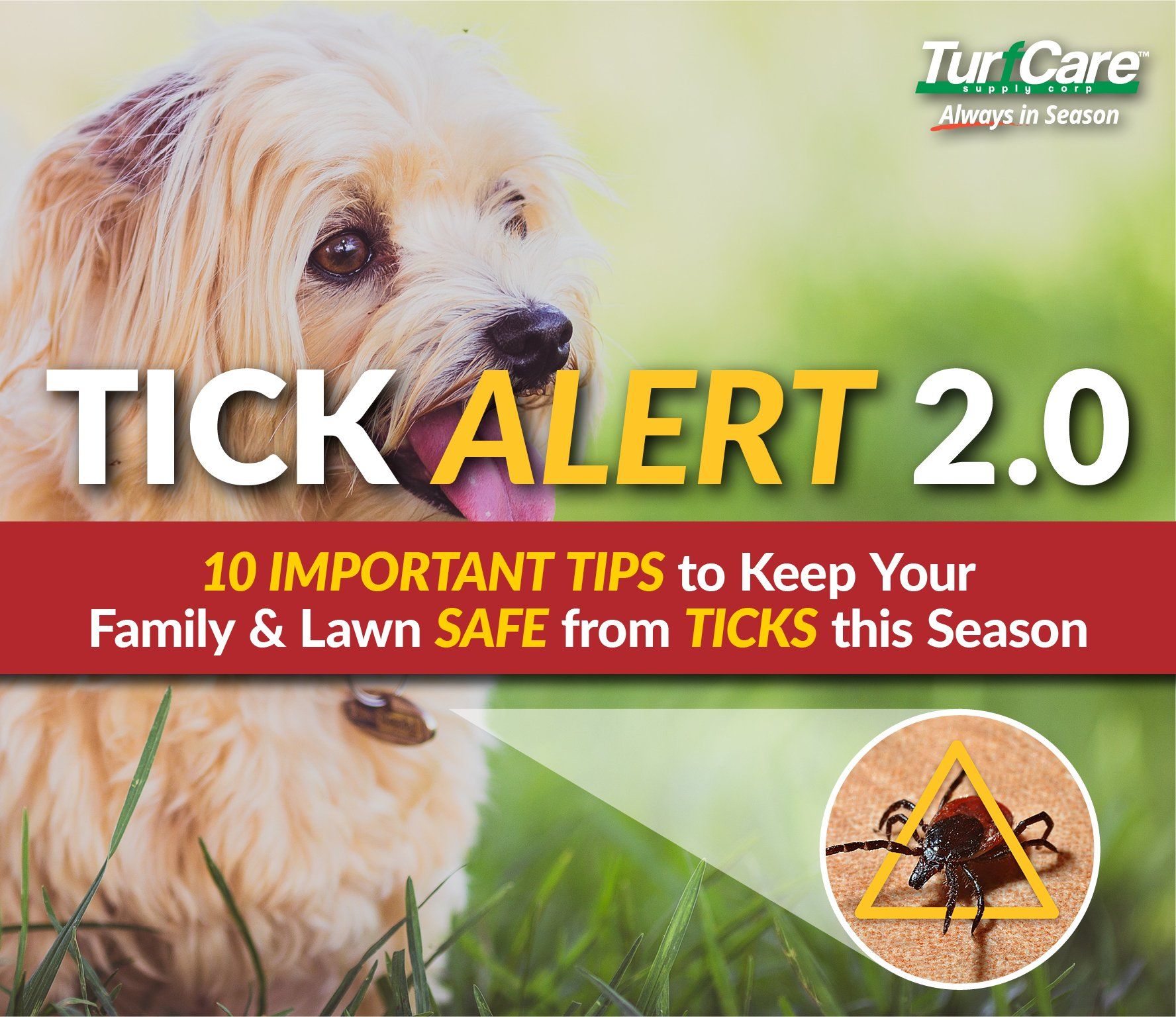Tick Alert 2.0 - 10 IMPORTANT TIPS to Keep Your Family & Lawn Safe from Ticks this Season!

With rising summer temperatures and mild winters, the dangerous tick is growing in population in many different regions. Although ticks don’t pose a direct threat to the overall health of your turf, it does threaten the potential wellbeing of your family, friends, pets and you as everyone enjoys your lawn this season! These pests hide in lawns and cause potential health risks like skin irritation, fever, aches & pains, rashes and diseases like Lyme disease, southern tick-associated rash illness (STARI), Rocky Mountain spotted fever (RMSF), ehrlichiosis, and tularemia as well as, although rare, the deadly Powassan virus (often carried by blacklegged ticks) or paralysis. It’s important to understand that with ticks’ populations on the rise, there is an increased risk of contracting these diseases. This may seem a little concerning but don’t fret; by following these 10 tips you can keep your family and lawn safe this season.
1. MOW RIGHT!
Mowing your lawn to the correct height will reduce the likeliness of tick infestation since they hide in longer grass. Proper mowing heights will also attract natural tick predators. NOTE: Be sure to research or consult a lawn care expert about the grass species in your area for mowing specifications in the heat of summer.
2. WATER WISELY
Water turf deeply and infrequently. Avoid overwatering. Ticks like moist areas and an overly watered lawn is an open invitation for invasion. For lawns with drainage issues, try aeration. A good rule of thumb is to give your lawn 1-1.5 inches of water a week (1 inch of water = 1 hour of sprinkling). How often you water varies on grass and soil types. If you are in unsure of the grass and soil types in your area, check with the Cooperative Extension or your local water authority office for help determining types and the recommended irrigation schedules for your area.
3. PROTECT YOUR LAWN & HOME WITH A CONTROL PRODUCT
Conventional insecticides can suppress ticks throughout its lifecycle; check the product’s label to ensure that this pest is controlled. The best time to treat your lawn for ticks is during late spring-early summer. A single application of a control product will manage summer tick season. Review all label instructions of the insecticide purchased for proper directions of use.
- NOTE: If you didn’t treat for ticks in Spring, an application can be applied in early Fall to control adults. Be aware of the label instructions for duration of control if you plan to apply in Spring.
List of professional insecticides known to control ticks
- Allectus® (Imidacloprid and Bifenthrin)
- Imi-Lambda® (Imidacloprid and Lambda-cyhalothrin)
- NOTE: Listed technologies are proven to work on tick infestation problems. Not all insecticides that target ticks are listed here; there are other options out there, be sure to do your research and read label instructions before using any insecticide.
4. A NEAT YARD IS KEY!
Keeping the yard clean from debris like piles of lumber, brick, stone and wood, brush, excessive leaf litter, and tall weeds throughout the season helps to eliminate potential habitats for ticks to reproduce and hide.
5. REDUCE WILDLIFE
Ticks favor warm-blooded urban wildlife like squirrels, mice, rabbits, feral cats, deer, raccoons and skunks. If you frequently receive visits from wildlife like this, reduce your yard’s appeal by seeking out excessive trash that animals may get into, remove birdfeeders and consider the vegetation in gardens these animals may be feeding on. Never allow wildlife to make a home around decks, sheds, barns, or other potentially welcoming areas around the property.
- NOTE: If skunks are seen prowling around your lawn, it may be a sign you have a grub infestation as well.
6. CREATE A SAFE ZONE
If woods are located near your property, create a barrier that limits tick migration by removing leaf litter, weeds and brush.
7. DON’T WELCOME TICKS INSIDE YOUR HOME
Protect ticks from getting into your home by forming roughly a 6-inch wide clean area around your home by picking up brush, leaf litter and eliminating weeds to remove potential hiding places.
8. INSPECT PETS’ HANGOUTS
Ticks enjoy latching onto pets which can cause the pest to hitch a ride indoors. Check and treat pet areas, especially in shady, cool spots for ticks. Consider putting down cedar mulch in these areas because it naturally repels these pests.
9. WELCOME NATURAL PREDATORS AND NATIVE PLANTS!
Mowing your lawn to the correct height and adopting a continuous lawn care program of fertilization, control products and soil amendments, proper irrigation, aeration and thatch management can help attract natural predators to ticks as well as encouraging native plant growth for a healthy and balance lawn that will naturally prevent ticks.
10. WELCOME THE SUNSHINE!
Ticks love shady, moist areas. Introduce more sunshine into a landscape by pruning trees and shrubs.
- NOTE: It's important to understand that a tick bite can happen to anyone. By following these steps you will significantly decrease your family's and your chances of receiving a tick bite. If you do discover a tick on yourself or someone else, its important to understand how to properly and safely remove them. CLICK HERE for more tips on how to check for and remove ticks from a body.
For professional fertilizers, humic and AMP-XC™ enriched products available, please visit TurfCare’s online Product Catalog.
For green industry professionals or others interested in ordering Turfcare products, please contact our Customer Service to find a distributor near you.
The TURFReport Highlights:
Additional Articles and Insights
















